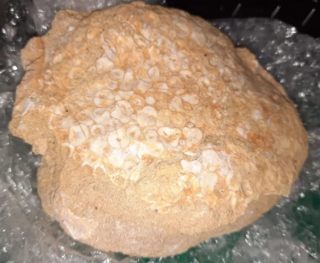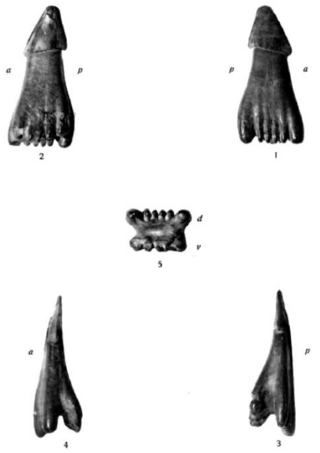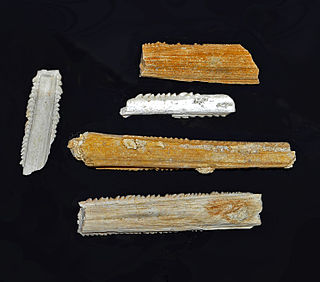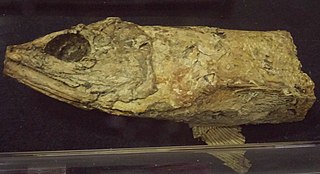
The Lamniformes are an order of sharks commonly known as mackerel sharks. It includes some of the most familiar species of sharks, such as the great white as well as less familiar ones, such as the goblin shark and megamouth shark.

Squalicorax, commonly known as the crow shark, is a genus of extinct lamniform shark known to have lived during the Cretaceous period. The genus had a global distribution in the Late Cretaceous epoch. Multiple species within this genus are considered to be wastebasket taxon due to morphological similarities in the teeth.

Enchodus is an extinct genus of aulopiform ray-finned fish related to lancetfish and lizardfish. Species of Enchodus flourished during the Late Cretaceous, where they were a widespread component of marine ecosystems worldwide, and there is some evidence that they may have survived to the Paleocene or Eocene; however, this may just represent reworked Cretaceous material.

Sclerorhynchus is an extinct genus of ganopristid sclerorhynchoid that lived during the Late Cretaceous. The genus Ganopristis is considered a junior synonym of Sclerorhynchus. It was a widespread genus, with fossils found in the Middle East, North Africa, Europe, and North America. While it had a long rostrum with large denticles similar to sawfishes and sawsharks, its closest living relatives are actually skates. Complete specimens of S. atavus show that its fin arrangement was similar to skates, with the pectoral and pelvic fins touching, both dorsal fins located behind the pelvic fins, and a reduced caudal fin.

Eodiaphyodus is an extinct genus of marine phyllodont ray-finned fish known from Late Cretaceous sediments across Africa. As with other members of its family, it is primarily known by its fossilized tooth plates, which were likely found in the back of its throat and used to crush its food.

Dalpiazia is an extinct genus of sclerorhynchoid fish whose fossils are found in rocks dating from the Maastrichtian stage in mines in Jordan, Libya, Morocco and Syria. The type species D. stromeri was named by Checchia-Rispoli (1933) in honor of Ernst Stromer, and the holotype, a rostral tooth, was found in Tripolitania, Libya.

Rhombodus is a prehistoric genus of ray belonging to the family Rhombodontidae.
The Quiriquina Formation is a geological formation in Chile whose strata date back to the Late Cretaceous. Dinosaur remains are among the fossils that have been recovered from the formation. The glauconitic sandstones and conglomerates of the formation were deposited in a marine environment.
Clupavus is an extinct genus of marine ray-finned fish that lived during the middle of the Cretaceous period. It is known from North Africa, Europe, Brazil, and possibly North America.

Tselfatia is an extinct genus of Cretaceous bony fish. Originally described from Djebl Tselfat in Morocco, it has since been discovered at sites in several other countries. The type species, Tselfatia formosa, was named and described in 1943 by French paleontologist Camille Arambourg. A second species, T. dalmatica, was named in 1980 from the Dalmatian Coast of Croatia.

Onchopristis is an extinct genus of sclerorhynchoid from the Cretaceous of North Africa, Europe, North America, and potentially South America. It contains two valid species, O. numida and O. dunklei, though some researchers argue that both may be considered a single taxon with variation in morphology caused by a wide geographical range. Specimens of Onchopristis have been discovered in coastal and fluvial deposits dated from the Barremian to the Cenomanian ages, making this genus one of the oldest known sclerorhynchoid.
Pattersonellidae is an extinct family of primitive ray-finned fish. It is tentatively classified under the suborder Argentinoidei of the order Argentiniformes.

Cretalamna is a genus of extinct otodontid shark that lived from the latest Early Cretaceous to Eocene epoch. It is considered by many to be the ancestor of the largest sharks to have ever lived, such as Otodus angustidens, Otodus chubutensis, and Otodus megalodon.
This list of fossil fish species is a list of taxa of fish that have been described during the year 2012. The list only includes taxa at the level of genus or species.

Serratolamna is an extinct genus of mackerel sharks that is placed in the monotypic family Serratolamnidae.

Sclerorhynchoidei is an extinct suborder of rajiform rays that had long rostra with large denticles similar to sawfishes and sawsharks. This feature was convergently evolved, recently proposed as 'pristification', and their closest living relatives are actually skates. While they are often called "sawfishes", sawskates is a more accurate common name proposed in 2021 for sclerorhynchoids, which has been subsequently used by other researchers.

Goulmimichthys is an extinct genus of ray-finned fishes in the family Pachyrhizodontidae. The genus, first described by Cavin in 1995, is known from various Turonian age formations. The type species G. arambourgi from the Akrabou Formation in the El Rachidia Province of Morocco, and other fossils described are G. gasparini of the La Frontera Formation, Colombia, and G. roberti from the Agua Nueva Formation of Mexico.

Atlanticopristis is an extinct genus of sclerorhynchoid that lived during the Late Cretaceous (Cenomanian) of what is now the Northeast Region of Brazil, between 100.5 and 93.9 million years ago. It contains a single species, Atlanticopristis equatorialis, originally assigned to the closely related genus Onchopristis.
Biropristis is an extinct genus of sclerorhynchoid from the Late Cretaceous epoch of the Cretaceous period. The genus is named in honor of Dr. Lajos Biró-Bagózcky who studied the formation in which it was found. It is known from a single species, B. landbecki. It is known solely from isolated oral teeth found in the Maastrichtian-aged Quiriquina Formation of central Chile. The species is named for Luis Landbeck who found the first fossils at the locality in which it was found.
Ganopristidae is an extinct family of cartilaginous fish from the Cretaceous belonging to the suborder Sclerorhynchoidei. While the name Sclerorhynchidae is often used for this family, it is a junior synonym of Ganopristidae. This family contains the genera Libanopristis, Micropristis, and Sclerorhynchus. The type genus Ganopristis is considered to be a junior synonym of Sclerorhynchus.














